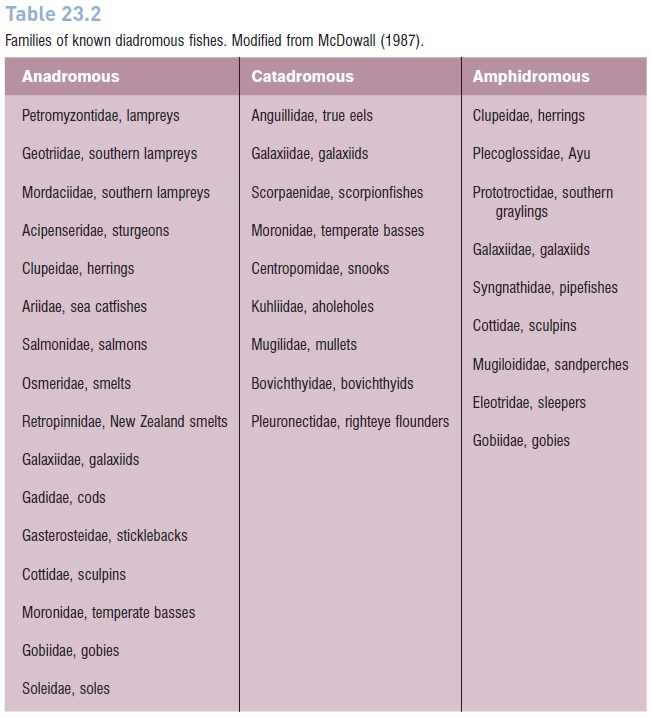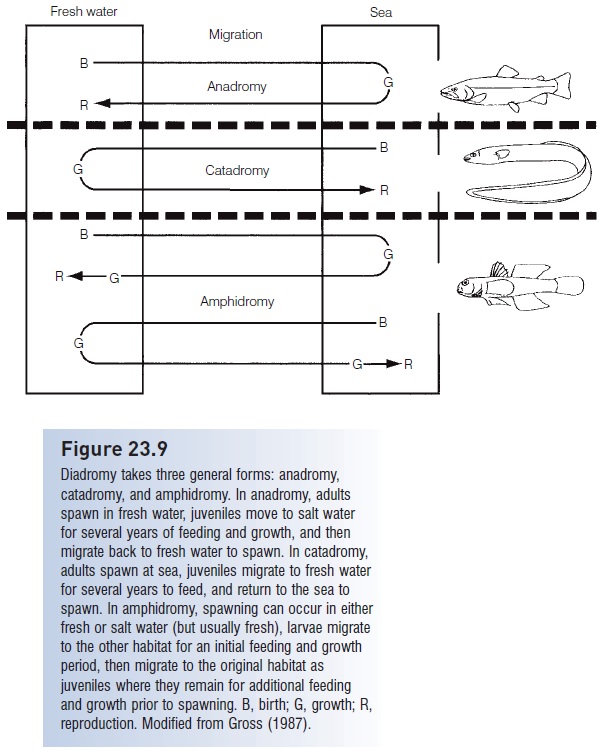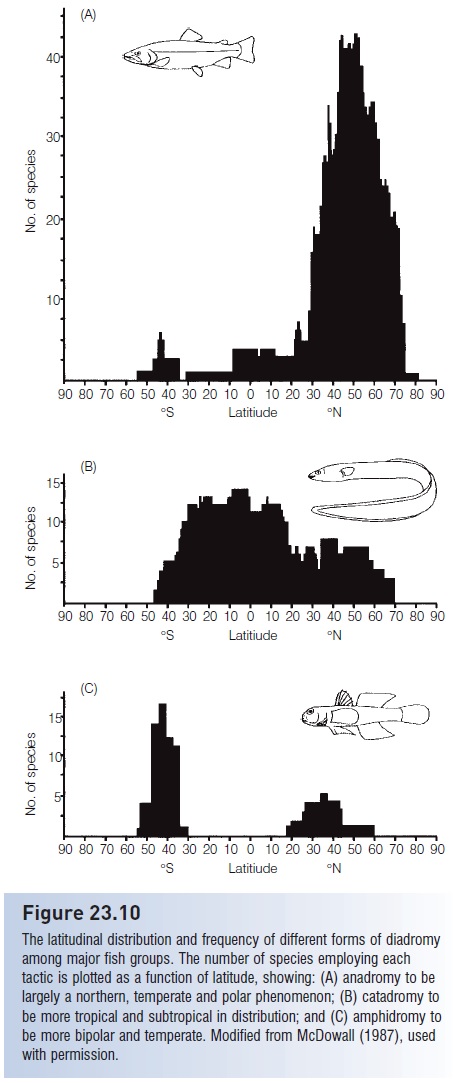Chapter: The Diversity of Fishes: Biology, Evolution, and Ecology: Cycles of activity and behavior
Diadromy - Annual and supra-annual patterns: migrations of Fishes
Diadromy
Many species of migratory fishes move predictably between fresh and salt water at relatively fixed times in their lives. Thesediadromous (“running between two places”) fishes include about 160 species, or a little less than 1% of all fish species, but many of them are very important commercially and their complex life histories are fascinating (Table 23.2). Diadromy takes three different forms, anadromy, catadromy, and amphidromy (Fig. 23.9). Anadromous fishes such as lampreys, sturgeons, shads, Pacific salmons, smelts, and Striped Bass spend most of their lives in the ocean and
Table 23.2
Families of known diadromous fishes. Modified from McDowall (1987).

Figure 23.9
Diadromy takes three general forms: anadromy, catadromy, and amphidromy. In anadromy, adults spawn in fresh water, juveniles move to salt water for several years of feeding and growth, and then migrate back to fresh water to spawn. In catadromy, adults spawn at sea, juveniles migrate to fresh water for several years to feed, and return to the sea to spawn. In amphidromy, spawning can occur in either fresh or salt water (but usually fresh), larvae migrate to the other habitat for an initial feeding and growth period, then migrate to the original habitat as juveniles where they remain for additional feeding and growth prior to spawning. B, birth; G, growth; R, reproduction. Modified from Gross (1987).

Many anadromous species (Sea Lampreys, Alewives, Blueback Herring, Atlantic Salmon, Sockeye Salmon, Rainbow Trout) develop landlocked populations that never migrate to the sea but instead spawn in inlet streams to large lakes. Catadromous fishes such as anguillid eels, mullets, temperate basses, and some sculpins spend most of their lives in fresh water and then return to the ocean to spawn. Amphidromous fishes (Ayu, galaxiids, southern graylings, sandperches, sleepers, gobies) move between marine and fresh water at certain phases of their lives, but the final migration occurs long before maturation and spawning occur. The chief distinction between amphidromy and anadromy is that the migration into fresh water usually occurs in the juvenile stage in amphidromy and in the adult stage in anadromy (McDowall 2007). About half of all diadromous fishes are anadromous, the other half equally divided between catadromous and amphidromous forms (McDowall 1987, 1988, 1999).
The geographic distribution of the different forms of diadromy is interesting because it provides insight into the evolution of the behavior (Fig. 23.10). Anadromy is largely a northern hemisphere, high-latitude phenomenon, catadromy is more common at low latitudes and in the southern hemisphere, and amphidromy has a bimodal distribution at middle latitudes in both hemispheres, with greater representation in the southern hemisphere (McDowall 1987). Interpretations of why different forms of diadromy prevail at different latitudes are confounded by phylogenetic histories, but one appealing analysis views diadromous migrations as complex adaptations that function to place both larvae and adults in environments where food is most abundant (Gross 1987; Gross et al. 1988; see Dodson 1997 for a critique). For a long-distance migration to evolve, the gains in fitness from moving must exceed the fitness an individual would have achieved had it remained in its original habitat. Gains have to be suffi ciently large to also overcome losses – including osmotic costs, energy and time lost, and predation risk – incurred while migrating. If an individual migrates during its life, it should ideally (i) spawn in a place of low predator density to minimize egg mortality but where (ii) larvae can drift passively to locations of higher productivity appropriate to their growth needs, and (iii) place juveniles and young adults in areas where they can maximize their feeding, thus allowing them to build up energy stores necessary for (iv) the long migration back to the optimal (low productivity) spawning locale.

Figure 23.10
The latitudinal distribution and frequency of different forms of diadromy among major fish groups. The number of species employing each tactic is plotted as a function of latitude, showing: (A) anadromy to be largely a northern, temperate and polar phenomenon; (B) catadromy to be more tropical and subtropical in distribution; and (C) amphidromy to be more bipolar and temperate. Modified from McDowall (1987), used with permission.
Available evidence indicates very different growth and reproduction rates in the different habitats. Juvenile Pacific salmon may increase their daily growth rate by 50% during their first week in the ocean. Sockeye Salmon, Oncorhynchus nerka, are referred to as Kokanee when landlocked and seldom attain 25% of the body size of anadromous individuals. Comparisons between diadromous and nondiadromous stocks of the same salmonid species (Cutthroat Trout, Rainbow Trout, Atlantic Salmon, Brown Trout, and
Mortality rates are difficult to estimate; however, the three-fold reproductive advantage of diadromy would more than make up for greater mortality at sea before the benefits of diadromy were negated.
Combining such growth and reproduction differences with information about relative productivity of fresh waters and oceans at different latitudes suggests that the temperate prevalence of anadromy and more tropical occurrence of catadromy are evolutionary logical. In temperate regions, oceans tend to be more productive than fresh waters, whereas fresh waters are more productive than the ocean in tropical regions. Hence the primary feeding habitat for a migratory species should be the ocean at high latitudes versus rivers and lakes at lower latitudes. The survival of young may be enhanced if spawning occurs where productivity, and also presumably predation, are least: streams and rivers at high latitudes, the ocean at lower latitudes. As long as the costs of movement between spawning and growth habitats are not excessive, the existence of anadromy in colder climates and catadromy in warmer climates appears adaptive. Amphidromy may serve as an intermediate or stepping stone condition in the evolution of anadromy or catadromy (the catadromous nature of American and European eels, discussed below, may reflect the evolutionary history of the family, which is primarily tropical and which still entails spawning at tropical latitudes) (Gross 1987; Gross et al. 1988).
Related Topics